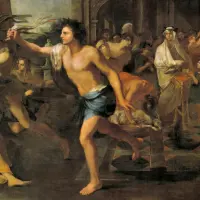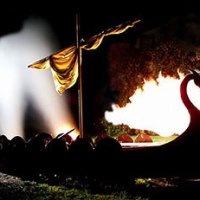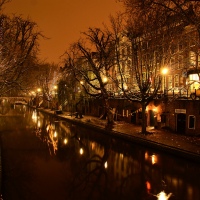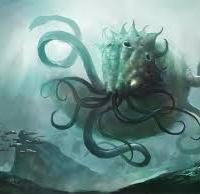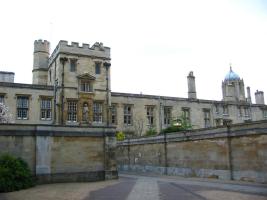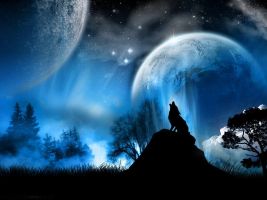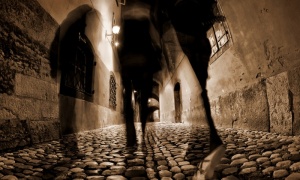With Christmas fast approaching and the ghost story season with it, this is perhaps a useful time to ask where the phenomenon of the Haunted House story first came from. For some, what effectively launched the genre of Haunted House stories was The Haunted and the Haunters, described by H P Lovecraft himself as “one of the best short haunted house tales ever written.” It is based on reports the writer, Edward Bulwer-Lytton, had heard about a building in the heart of London’s Mayfair, but it is also perhaps based on his own real life experiences. Lytton was born in London in 1803 and, despite his noble birth, was forced to earn his living as a writer, until he inherited the title of Lord Lytton in 1866. In the interim, he had become popular with readers for his historical novels – notably The Last Days of Pompeii (1834) – and a number of stories of the occult and supernatural. Highly regarded among these are his novel A Strange Story (1861) and short story Glenallan. The family seat of Lord Lytton was Knebworth House, a notable Tudor mansion, with a beautiful Jacobean banqueting hall, overlain with a 19th century Victorian Gothic exterior. Knebworth House has been the home of the Lytton family since 1490 and boasts some hauntings of a deeply personal nature. For example, the family is warned of an impending death by the sound and occasional sighting of a girl named Jenny, spinning. Other phenomena include a presence in the rooms once frequented by Edward Bulwer-Lytton himself, who died in 1873, and some believe he may have decided to remain there. “The pen is mightier than the sword” – an iconic proverb coined by Lytton in 1839 – is a phrase which makes regular appearances to this very day; just like its creator, the ghost of whom is said to haunt the gothic stately home where he once lived.
Haunted Holland
28 Oct
Here’s a special pre-Halloween treat for all of you – a post about Utrecht, the most haunted city in the Netherlands! Founded by the Romans in 47 AD, Utrecht was one of the first places in the Netherlands to embrace Christianity, and in the Middle Ages it grew into an important religious centre. The city retains many of its medieval churches and monasteries – wandering the backstreets it is possible to revel in the architectural reminders of past centuries. But there is also a darker aspect to this history. During the horrific witch hunts of the 16th century, thousands of women all over the country were executed – burned, drowned or otherwise tortured to death – on suspicion of witchcraft. Weighing was one of the more common methods of determining witchery, as a popular belief held that any woman who was too light for the size of her frame was obviously a witch (because hags like that have no soul). The nearby town of Oudewater emerged with some honour – no one was ever proved to be a witch here and this is held up as a symbol of the honesty of the locals, who refused to take bribes to rig the weights. It is also seen as the first stirrings of people power and a turn against the church, which was behind the witch-hunts.
Five things to do this Halloween
31 Oct
If you’re at a loose end this Halloween and in the mood to be scared silly, here are some suggestions courtesy of Ghost Cities:
1 Thing to watch – the Babadook will scare you silly…
1 Thing to read – one classic by Wilkie Collins and one modern chiller by Joe Hill (slightly cheating here with two but I couldn’t resist!)
1 Thing to visit – the Witches and Wicked Bodies exhibition at the British Museum: just about the scariest place to visit this Halloween!
1 Thing to eat – here’s a ghoulishly good recipe for that old favourite: pumpkin pie!
1 Thing to listen to – what else but Saint-Saëns’ Danse Macabre?
Enjoy – Happy Halloween!
The Ghosts of Haddon Hall
7 Jun
Haddon Hall, perhaps the most simple and understated of English stately homes, is also one of the finest medieval manor houses in Britain. Nestled in the heart of the Peak District National Park, it certainly enjoys a picturesque setting, two miles south of Bakewell (known for its eponymous tarts) on the banks of the River Wye. In the mid-twelfth century the hall passed from its Norman founders to the Vernon family, who owned it for four hundred years until the most famous event in its history occurred. In 1558 the sole remaining Vernon heir, Dorothy, married John Manners, scion of another powerful family who later became Dukes of Rutland. Their union is commemorated in their joint tomb in Bakewell church, but the romantic story of their elopement may be apochryphal. Dorothy Vernon was 18 at the time and it is said that the couple eloped during the wedding of one of her sisters. There must have been some sort of reconciliation, as Dorothy and John later became owners of Haddon Hall. The hall has been owned by the Manners ever since then, but curiously enough has never been sold. The mansion fell into two hundred years of neglect from the start of the eighteenth century until the 9th Duke began restoring Haddon Hall when he moved there in 1912. No one quite knows the reason for the building’s neglect and seeming lack of interest to buyers – although this may have something to do with the fact that the ghost of Dorothy Vernon is said to appear there on a regular basis, usually seen on the steps leading up to Haddon Hall, as if being chased.
Midwinter Ghosts
15 DecThere is something about the festive season that irresistibly brings ghosts to mind. Who can tell whether it is the wintery chill, the creeping mist or the inscrutable blanket of snow, but the period approaching Christmas seems inextricably bound with the supernatural. A traditional time for tales of unquiet spirits and the restless dead, the Yuletide season has inspired writers from Charles Dickens to M R James to write ghost stories either during or expressly set at Christmas. But is there perhaps more to this? Are these fictional ghostly tales actually based on real-life paranormal occurrences? There is no shortage of material to support such a conclusion – in Britain alone, there are spooky stories of things that go bump in the night each Christmas that span the length and breadth of the country. From spirits that roam the bleak North York Moors, to haunted houses in the garden of England, from ghastly deeds in the cobbled streets of old London town to dark legends of the highlands of Scotland, almost every region has its own chilling seasonal tales to recount. So, whilst everyone else is buying presents and preparing for Christmas parties, spare a thought for the more sinister side of the festive period and its very own Midwinter ghosts.
The Awakening
17 NovIn the period between Halloween and Christmas, with the country in the icy grip of winter and the nights long and cold, there is nothing like a good scary ghost story to bring family and friends together around the hearth. One of my favourites in this particular film genre is 2001’s The Others, the sort of suspenseful chiller which doesn’t seem to come around too often, given the modern preference for out-and-out shocks and gore in horror movies. Probably the best recent example of a film in the mould of The Others is 2011’s The Awakening, starring Rebecca Hall and Dominic West. In post-World War I England, an author and paranormal sceptic (Hall) is invited to a countryside boarding school by one of the teachers (West) to investigate rumours of an apparent haunting. But just when she thinks she has debunked the ghost theory, she has a chilling encounter which makes her question all her rational beliefs. Call me old-fashioned, but I think that there’s something very clever about a film that is subtle enough to scare and unsettle its audience by placing suspense, atmosphere, a gripping plot and a quality script and actors at its heart. As an added bonus, The Awakening also has one of those jaw-dropping twists at the end that make you question everything that you’ve just witnessed. If you enjoy films like The Sixth Sense, An American Haunting and The Woman in Black, you’ll probably need to make room on your DVD shelf for The Awakening.
Phantoms and Faders in Old London Town
2 SepWith the Olympics not long past and the Paralympics still upon us, I thought that this might be an opportune moment to consider the haunted history of the UK’s capital city. There is certainly no shortage of material to draw upon when investigating the strange past of London, for just as it has been central to many of the major event’s in the nation’s history, it has also been equally famous as a city of vice, sin, crime and bloodletting. The grim legends of Jack the Ripper, Springheeled Jack and Sweeney Todd continue to cast a menacing shadow over the grimy streets of the East End. Bram Stoker may have made London Dracula’s main preying ground in his iconic horror novel, but the dark Count is seemingly very far from the only vampire – real or fictional – who has flitted through the city’s shadows. Similarly, the plot of Jonathan Landis’s American Werewolf in London also has its terrifying basis in reality. Many of the phantoms that are said to roam the capital are an essential part of British history, folklore and legend. The Tower of London, for example, is reputedly England’s most haunted building precisely because of the many who perished within its walls. There is an old saying that ghosts only ever appear in places that have known either great happiness or great misery, and the buildings and the haunted streets of London have certainly known both in abundance. The countless numbers of people who have lived and died in London in the course of its almost two thousand years of history had known every human emotion – among them hope, joy, love and, of course, terror. In consequence, there is not one square inch of old London town that is not imbued with the memories and experiences of its former citizens.
Royal Ghosts & Hauntings
10 Jun
With the Jubilee not long past I thought that this would be the ideal time to look at the long and storied history of Britain’s royal ghosts and hauntings. The most difficult part is knowing where to begin – one thing that this country does not have is a shortage of tales of blue-blooded phantoms and faders. There is the ghostly lantern-carrying groom of Althorp in Northamptonshire, the spectral limping priest of Amersham, the blood-curdling screams of Edward II in Berkeley Castle, the decapitated head of Charles I seen floating around Billingham Manor, the various phantom coaches of Norfolk, the duelling knights with fiery swords at Blofield, the disguised queen at Borthwick Castle and the crazed laughter of Queen Isabella at Castle Rising. Royal ghosts haunt the New Forest, Hampton Court Palace and St James’s Park. Windsor Castle, one of the main royal residences, is also one of the most haunted. It somehow seems fitting that a royal line with a history as long, colourful and often lurid as that of the British Isles should boast so many ghost stories. But is there a deeper, darker reason for the prevalence of malevolent spirits in relation to the British Crown?
Paranormal Activity: The Enfield Poltergeist
16 Nov
In all the annals of the investigations of the Society for Psychical Research (SPR), whose history stretches back almost 150 years, there is no account as chilling as the affair of the Enfield Poltergeist. This is the name given to a period of apparent poltergeist activity in the Enfield borough of London at the end of the 1970s. Poltergeist is a term of German derivation literally meaning ‘noisy ghost’ and refers to a paranormal phenomenon which consists of events alluding to the manifestation of an imperceptible entity. Such manifestation typically includes inanimate objects moving or being thrown about, sentient noises (such as impaired knocking, pounding or banging) and, on some occasions, physical attacks on those witnessing the events. Poltergeists have traditionally been described in folklore as troublesome spirits or ghosts which haunt a particular person, although no conclusive scientific explanation of the phenomenon exists. The Enfield case exhibited all of the classic hallmarks of poltergeist activity, including furniture reported to have moved by itself, knockings on the walls, and items said to have been thrown around and to have been too hot to touch when picked up.
The Murder Tree
6 NovThere is an old story that is sometimes set in Yorkshire, England, sometimes in San Francisco, California and sometimes in Adelaide, Australia that goes something like this: one summer night in the year 1750, 1850 or 1950, a wealthy landowner, rancher or industrialist by the name of Timothy Lance, Thomas Read or Lance Thompson came home to find his wife and two children shot to death in their beds. The murderer was the estate’s head gardener, groundsman or gamekeeper, whose name was Harold Logan, Henry Fish or Logan Henriksen, who was seen fleeing the grounds with a pistol in hand and blood spattered on his clothes. For the rest of his life the wealthy man (we’ll call him Tom for the sake of simplicity) was haunted by the loss of his family and by the fact that the murderer (let’s call him Logan) was never caught and punished for his brutal crime. Tom let his business sink slowly into bankruptcy and spent his final years in an asylum, a mere shadow of his former self. In its day, this was a crime that shocked the nation (whatever nation that really was), but in modern times it’s been all but forgotten except by trivia and history buffs. At least that’s the official version. The truth of what happened that fatal night has never been made public. You see, it’s not true that Logan escaped. He was in fact chased down and apprehended by Tom and his servants on the very night of the murders. The reason that Logan was never seen again is that Tom hanged him from the tallest tree on his estate – an ancient sycamore that afterwards earned the ominous title of the Murder Tree.






